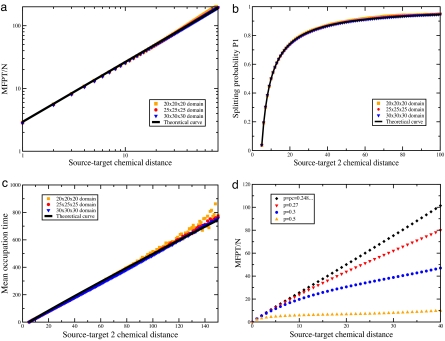Fig. 2.
Numerical simulation of first-passage observables for random walks on three-dimensional percolation clusters. All of the embedding domains have reflecting boundary conditions. (a) MFPT for random walks on 3-dimensional critical percolation clusters. For each size of the confining domain, the MFPT, normalized by the number of sites N, is averaged both over the different target and starting points separated by the corresponding chemical distance, and over percolation clusters. The black plain curve corresponds to the prediction of Eq. 15 with dwc − dcf ≃ 1. (b) Splitting probability for random walks on 3-dimensional critical percolation clusters. The splitting probability P1 to reach the target T1 before the target T2 is averaged both over the different target points T2 and over the percolation clusters. The chemical distance ST1 = 10 is fixed whereas the chemical distance ST2 = T1T2 is varied. The black plain curve corresponds to the explicit theoretical expression 14 with dwc − dfc ≃ 1. (c) Occupation time for random walks on critical percolation clusters. For each size of confining domain, the occupation time of site T1 before the target T2 is reached for the first time is averaged over the different target points T2 and over the percolation clusters. The chemical distance ST1 = 10 is fixed whereas the chemical distance ST2 = T1T2 is varied. The black plain curve corresponds to the prediction of Eq. 15 with dwc − dfc ≃ 1. (d) The MFPT for random walks on percolation clusters above criticality for a 25 × 25 × 25 confining domain. The MFPT, normalized by the number of sites N, is averaged both over the different target and starting points separated by the corresponding chemical distance, and over the percolation clusters.

